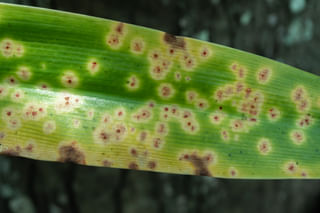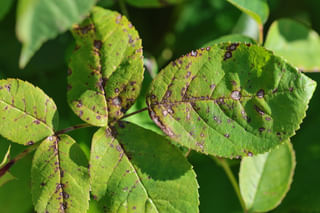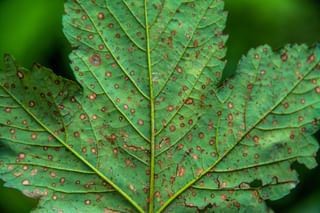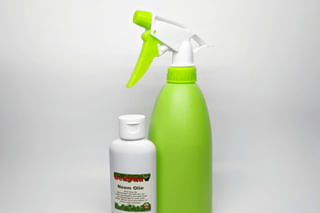What is leaf spot disease on houseplants?
Learn how to prevent and treat leaf spot disease on your houseplants with this comprehensive guide. Discover tips for proper watering, improving air circulation, using clean tools, and effective treatments like neem oil and baking soda spray to keep your plants healthy and thriving.
When you're taking great care of your houseplants, the last thing you want to see is leaves turning yellow or brown. But even scarier, is when dots or spots start to appear on your plant's leaves.
When this happens, you could be dealing with leaf spot disease on your plant. Leaf spot disease is a common problem for many houseplant owners. Knowing how to identify and understand plant diseases like leaf spot is key to keeping your plants healthy and beautiful.
In this plant care guide, we're going to look at these topics:
Let's learn a little more about what leaf spot disease is and what it looks like!
What does leaf spot disease look like?
Leaf spot disease includes various fungal and bacterial infections that cause spots to show up on plant leaves. The spots can differ in color, size, and shape, depending on the type of pathogen involved.
So let's look at what the different types of leaf spot diseases are on your houseplants.
Bacterial leaf spot
Bacterial leaf spot is often caused by bacteria like Xanthomonas or Pseudomonas. You'll notice water-soaked spots on the leaves that can turn brown or black over time.
Fungal leaf spot
Fungi such as Alternaria, Septoria, or Anthracnose are usually to blame when it comes to fungal leaf spot. They create round, brown, or black spots on the leaves, sometimes with a yellow halo around them.
Cercospora leaf spot
Cercospora leaf spots start as little dark spots and eventually develop gray or tan centers. These spots are mainly caused by fungi from the genus Cercospora.
The symptoms of leaf spot disease
Look out for discolored spots like yellow, brown, or black on the leaves. If you see yellowing around those spots, it's usually an early warning sign. Infected leaves might drop off sooner than expected, which can be a clear indication something's wrong.
The causes of leaf spot on houseplants

So what causes leaf spot disease? Well, each of the different types of leaf spot disease, we've looked at in the previous section, have quite similar causes. The most common cause of leaf spot disease, of any kind, is an environment that's too humid and warm for the plant.
Too much moisture
High humidity and overwatering can create an ideal environment for fungi and bacteria. Waterlogged soil and consistently damp leaves are perfect breeding grounds for pathogens, leading to diseases such as leaf spot.
Poor air circulation
Stagnant air helps pathogens grow by stopping moisture from evaporating off plant surfaces. This causes humidity to build up around the leaves, making it easier for diseases to spread.
One of the causes of poor air circulation is if you put too many plants closely together. Without enough space between plants, air cannot flow freely, leading to a micro environment that supports the growth of pathogens. Thinning out plants can significantly reduce the risk of disease.
High temperatures
Warm, damp conditions can lead to leaf spot diseases. Many pathogens do well in temperatures a bit above room temperature, especially when it's humid. So if the temperature is a little too high, make sure to keep the humidity levels a little lower.
Contaminated Tools
Besides environmental issues, you can also expose your plants to leaf spot disease by using contaminated tools. Unclean gardening tools can spread infections from plant to plant, so it's always important to clean your tools when you move from one plant to the next.
Now that we've seen the causes of leaf spot disease on your plants, we can look at a few different steps we can take to prevent these spots from showing up on your plant.
Preventing leaf spot on houseplants
To help prevent leaf spot disease from showing up on your houseplants, you've got to keep a close eye on the environment in which your plant is growing.
Water your plant properly
The first step to take is to make sure you're not overwatering your plant and you're not getting any water on your plant's leaves. You should water your plant when the top of the soil has dried out and when you water your plant, you should apply it to the soil directly.
This helps to keep moisture off the plant's leaves and reduces the risk of fungi attacking your plants.
When you water your plants, try to do so during the morning if you plan on getting moisture on your plant's leaves. The water drops on the leaves will evaporate during the day and this will help to prevent fungal infections.
Provide good air circulation
The second cause of leaf spot disease is poor air circulation, so a simple way to prevent leaf spots is to provide good air circulation. You can do this in 3 ways:
- Give your plants some space, don't overcrowd them
- Prune overgrown plants regularly to improve air circulation
- Place your plants in a well-ventilated room
You can choose one of these options or combine them to help improve the air circulation around your plant. This will help excess moisture evaporate more quickly and make it more difficult for fungi and bacterial diseases to settle on your plant.
Use clean tools
When you prune your plants, make sure to clean your tools when moving on to the next plant. There are a few ways to do this:
- Use a solution of bleach and water to kill any pathogens
- Use specialized disinfectants for tools
- Or my favorite, clean your tools with rubbing alcohol
By cleaning your tools, you prevent the spreading of bacteria and fungi from one plant to another.
Treating leaf spot disease on houseplants
Now that we've got a good idea of how to prevent leaf spot disease from showing up on our houseplants, let's see what you can do if your plant is already suffering from a type of leaf spot.
Neem Oil
Neem oil is a natural fungicide that's great for tackling leaf spot disease. You can use it on plants to prevent infections or treat existing ones. It's safe for most plants and even helps repel pests. With its antifungal properties, neem oil stops fungal spores from growing and spreading diseases.
Baking Soda Spray
Mix baking soda with water and a few drops of liquid soap to make a homemade remedy for fungal issues. Spray this mix on the affected areas to help control the spread. Baking soda works on fungi by raising the pH around the plant, making it more alkaline and less welcoming for fungal spores to grow.
Chemical Fungicides
If nothing else works, you can always try a specialized chemical fungicide. Products with copper or sulfur can be effective, but use them carefully and follow the instructions. Overuse can harm your plants and the environment, so stick to the recommended application rates and safety guidelines.
Conclusion
Catching leaf spot disease early and taking proactive care are key to managing it. By spotting the symptoms and knowing the causes, you can help prevent and control outbreaks.
When your plant happens to suffer from a type of leaf spot disease, not all is lost. With this guide, you should have all the tools to help your plant recover.
Thank you for reading this post! I hope it helps you to keep your plants healthy and beautiful! If you're looking for more guides on specific plants, you can always request a plant guide to get a guide for the plant you have trouble with.
Test your plant care knowledge
Quiz completed!
Want to learn more? Sign up for my newsletter to receive free tips in your inbox!
Sign up now!












